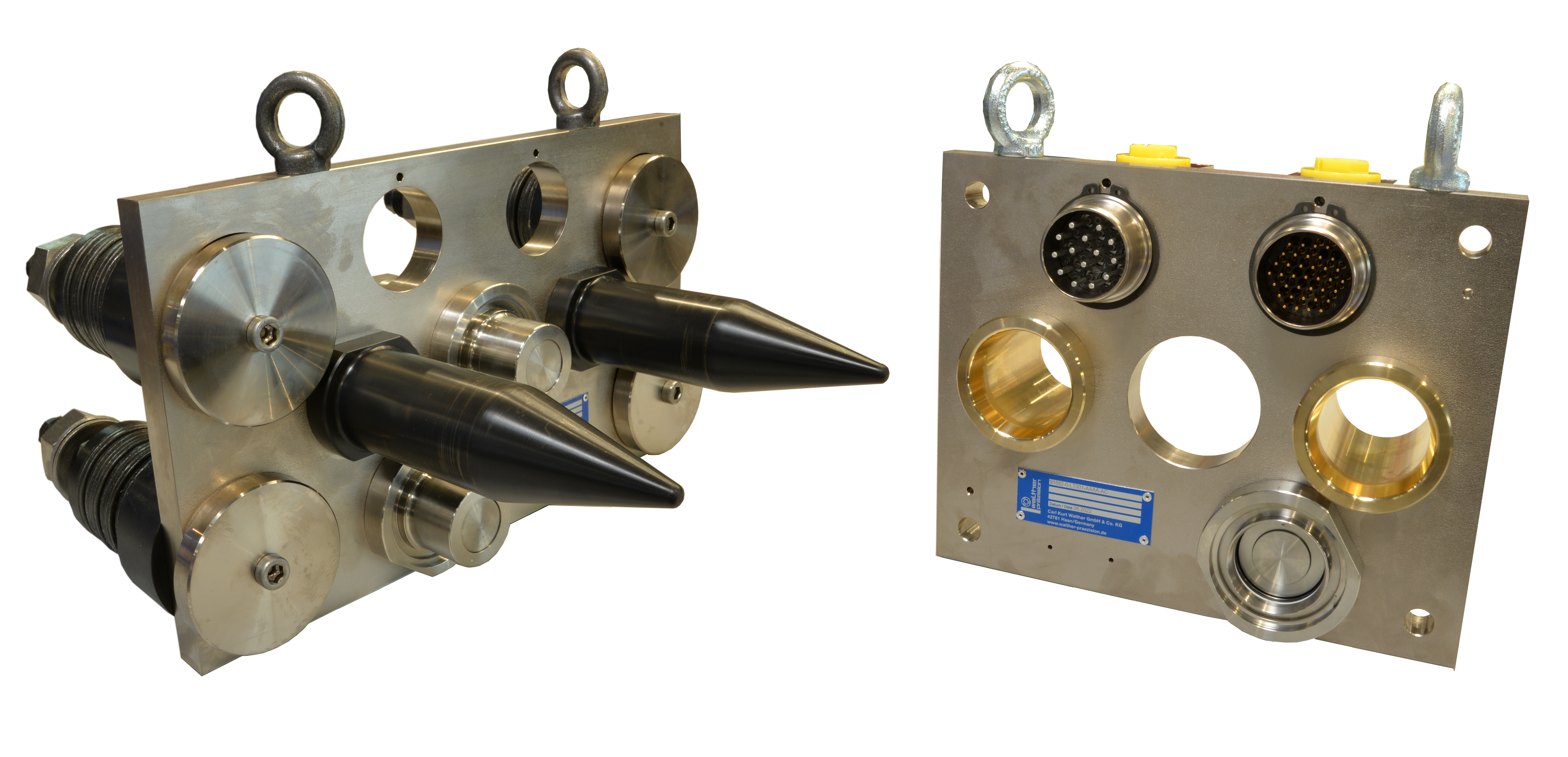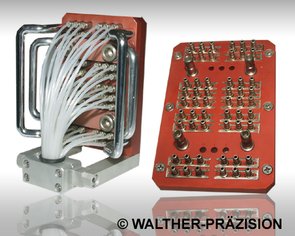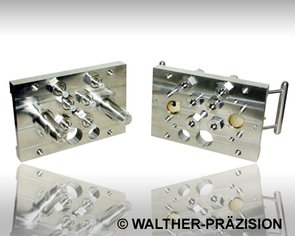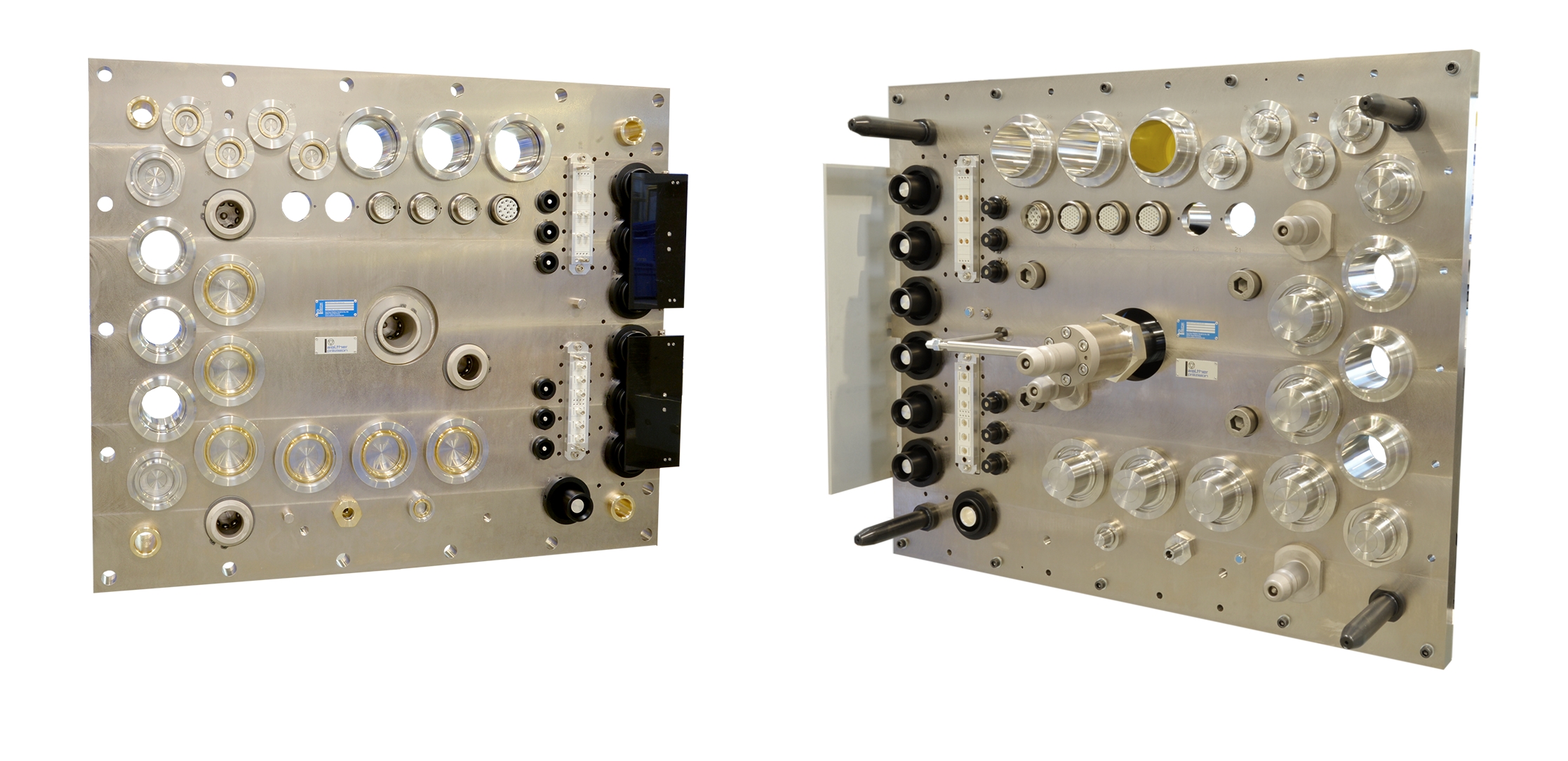As a manufacturer of multi-couplings, WALTHER-PRÄZISION develops and produces quick coupling systems that can simultaneously and repeatedly connect or disconnect (manually, pneumatically or hydraulically) a larger number of fluid and electric lines safely and quickly. Due to the fixed arrangement of the individual quick coupling elements on the carrier plates, connection mistakes are reliably eliminated.
Multi-couplings differ from mono-couplings in that they connect multiple lines at once, instead of just one. As a result, multi-couplings have the advantage that the lines are not unintentionally coupled incorrectly. In addition, the use of multi-couplings is associated with simplified handling, a standardisation of systems and considerable time savings during the assembly and maintenance of aggregates, systems and equipment. Quick and reliable disconnection and connection is possible at any time without additional tools. Multi-couplings consist of a free half and a fixed half, whereby the free half moves with the self-sealing coupling elements when it is connected to its counterpart with the adapter elements. The coupling elements are comprised of different thru-type, self-sealing or clean-break couplings, which are designed for various pressure ranges and media. These can be combined with power, measuring and electric connectors.
Multi-Couplings for hydrogen as an energy source
Multi-Couplings without connection assistance
Manually operated multi-couplings with connection assistance
Multi-Couplings for Testing of Hydrogen-Equipment
Multi-coupling and multi-coupling system designs and types
Multi-couplings differ from one another in terms of their design and coupling method: multi-couplings are available in a housing-type design, a compact design, a plate mounting or as a coaxial coupling. Manually operated multi-couplings with mechanical aid differ from simple manually operated multi-couplings. Manual multi-couplings without mechanical aid in a compact design are called fluidic multi-couplings. Multi-couplings and multi-coupling systems also include automatic docking systems as well as Tool changers for industrial robots, like those used in the automotive industry. Quick coupling systems for multiple lines are also used in other industries, such as transportation technology and the offshore technology industry or the steel industry, ever depending on whether manual multi-couplings with or without mechanical aid or high-precision automated docking systems are needed.
Manual multi-couplings without mechanical aid
Manually operated multi-couplings are available in different designs: a compact design with a central locking device, a housing-type design, a coaxial coupling or a plate mounting. The latter consist of two carrier plates and usually have a bracket safety device, whereby connecting and disconnecting is done by hand (without a motor or drive). Manually operated multi-couplings are used in transportation technology; for example, in stationary cooling systems in vehicles. In rolling mills and steelworks, manually operated multi-couplings are used for reels or on adjustable moulds in the casting process. As coaxial couplings that protect against dirt and moisture, multi-couplings are used in continuous casting installations for cooling electrical lines.
Manual multi-couplings with mechanical aid and their applications
On multi-couplings with mechanical aid, which are available in a compact design and a plate mounting, disconnection and connection of the multi-coupling halves is also done by hand; however, this is aided by a mechanism that increases the force and facilitates operation. Non-interchangeability of the lines is ensured by the design, but also by the corresponding colour markings or coding. In the automotive industry, manual multi-couplings with mechanical aid are used to supply power to pressing tools or welding tongs. In the offshore technology industry, multi-couplings with mechanical aid are installed for workover systems and feature a special locking mechanism to ensure they function reliably under water.
Servo-assisted docking systems with and without a feed unit
In contrast to manually operated multi-couplings, docking systems can connect or disconnect multiple lines with the aid of an electric, pneumatic or hydraulic drive. The couplings either have their own feed unit or are connected by means of existing movement processes. Docking systems without a feed unit can also be equipped with a mechanical locking mechanism that holds the plates together, even under heavy loads. Servo-assisted docking systems are used, for example, in the transportation industry as automatic docking systems for the simultaneous refuelling and draining of ferries. In the steel industry, automatic multi-couplings are used on cover-type annealing furnaces, in order to change the media supply. Docking systems are also used in the automotive industry; for example, at testing stations for car engines.
Tool changers for industrial robots
Docking systems are also used as tool changing systems for industrial robots. In autobody shell production in the automotive industry, they are used on welding or gripper tools for quick tool changes. Here, the robots have tool changers with different tools in several tool parking stations. Depending on their purpose, these docking systems are equipped with couplings for different fluid or gaseous media such as oil, compressed air or water and with electric or fibre optic cable connections.

 Highest quality
Highest quality


